Blog
Top credit union to work for offers endless time off, fully remote work

Written By: Ken McCarthy, American Banker
When Southwest Financial Credit Union started offering unlimited days off, its employees took that rule to heart, and spent 400 more hours away from work under the policy’s first year.
According to the Farmers Branch, Texas-based credit union, this is the policy working as intended —and the credit union benefits from clear boosts in retention, morale and member satisfaction.
The organization came in at No. 1 on this year’s American Banker Best Credit Unions to Work For list. Last year, the credit union placed third on the list and in 2021 Southwest Financial ranked second.
The winners were selected through two surveys: one that examined employee satisfaction and covered areas including leadership and planning, and a second survey that evaluated the benefits and policies of each credit union.
In an interview, Southwest’s President Melanie Kennedy said unlimited PTO has been a “huge bonus” for not only the credit union’s 28 employees but also its nearly 9,000 members.
“When your team members are happy, then your members are happy,” Kennedy said. “They can feel the difference between someone who wants to be at work and someone who doesn’t want to be at work. And I think that that translates to the bottom line.”
Kennedy said she believes that management should not get any perks that the rest of the team doesn’t — “we’re all on the same team and all get the same benefits” — so she had to lead by example and encourage people to use the PTO by doing so herself.
“So if you’re a workaholic, your team is also going to be workaholics,” she said. “I am a workaholic, and I take time off to have fun and to encourage others to know it’s really OK to use it.”
The strategy, implemented in 2022, seems to be working. So far this year, about 100 more hours have been used than would have been accrued, and Kennedy expects about 200 more hours to be used for the entire year compared to past years — below 2022’s peak of 400 hours, but still in excess of what employees used before.
Employees are more flexible when they don’t see their vacation time as a running tally. Previously, an employee might balk at being allowed only a half-day off during a busy season because it made it harder to use their remaining hours. Today, employees are more agreeable to the half-day because they can still use a full day at a more convenient time.
“People are happy because it’s not a use-it-or-lose-it situation,” Kennedy said.
The flexibility also extends to the work environment. Southwest Financial has no branches, and its staff is 100% virtual.
“And working from home really has brought a quality of life — a true work-life balance that we would have never seen before,” Kennedy said.
And with nearly 10 million job openings in the U.S., small companies like the $78 million-asset Southwest Financial need to do whatever they can to keep their employees looking for greener pastures. Cameron Boyd, managing partner of the financial services practice at the recruitment firm Smith &Wilkinson, said 75% of the nearly 90 placements the company made in 2022 were “net new” roles, such as dedicated chief information officer, chief risk officer or chief credit officer.
The U.S. Labor Force Participation Rate rose steadily in the years following World War II and peaked in the late 1990s as a result of higher Baby Boomer employment and women entering the workforce.
“But it’s been on a steady decline for the past 20-plus years, largely driven by the start of Boomer retirements and subsequent generations being smaller, and fell off of a cliff during the pandemic,” Boyd said.
“That means that organizations in all industries are hiring away from somewhere else if they’re hiring,” Boyd said. “The struggle is real across all industries, and most small, community financial institutions do not have a clear value proposition to prospective talent as to why they should quit their current job to come work for them.”
Boyd said the most important thing smaller banks and credit unions should do to strengthen employee retention is to embrace a culture of learning, development, and advancement. The young generations do not want to do the same job for 40 years; they want to be learning and growing and have a clear path to what’s next, he said. “While the majority of small financial institutions seem to be in-office cultures, employees want to know they have some flexibility, regardless of whether or not, or how often, they choose to work from home,” Boyd said.